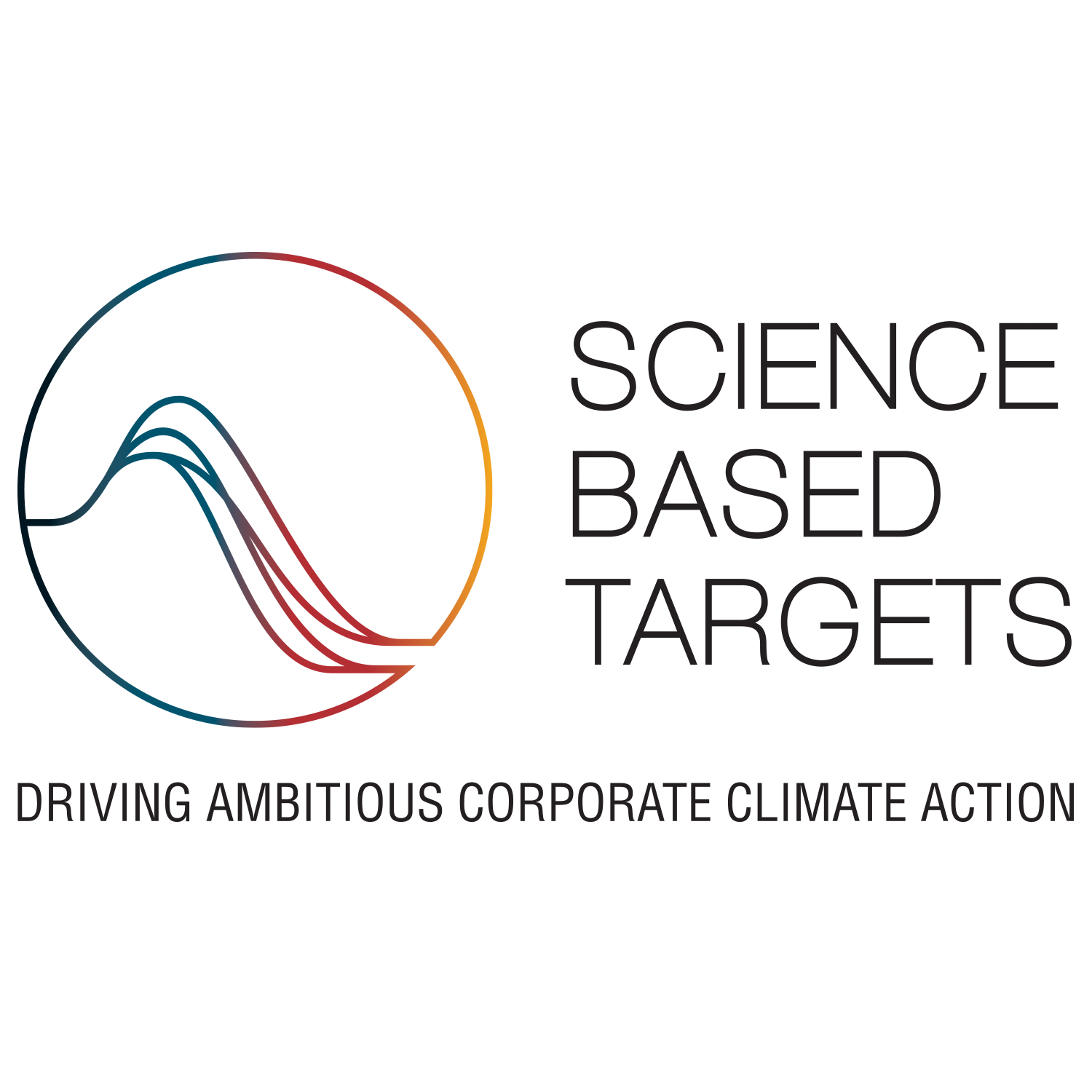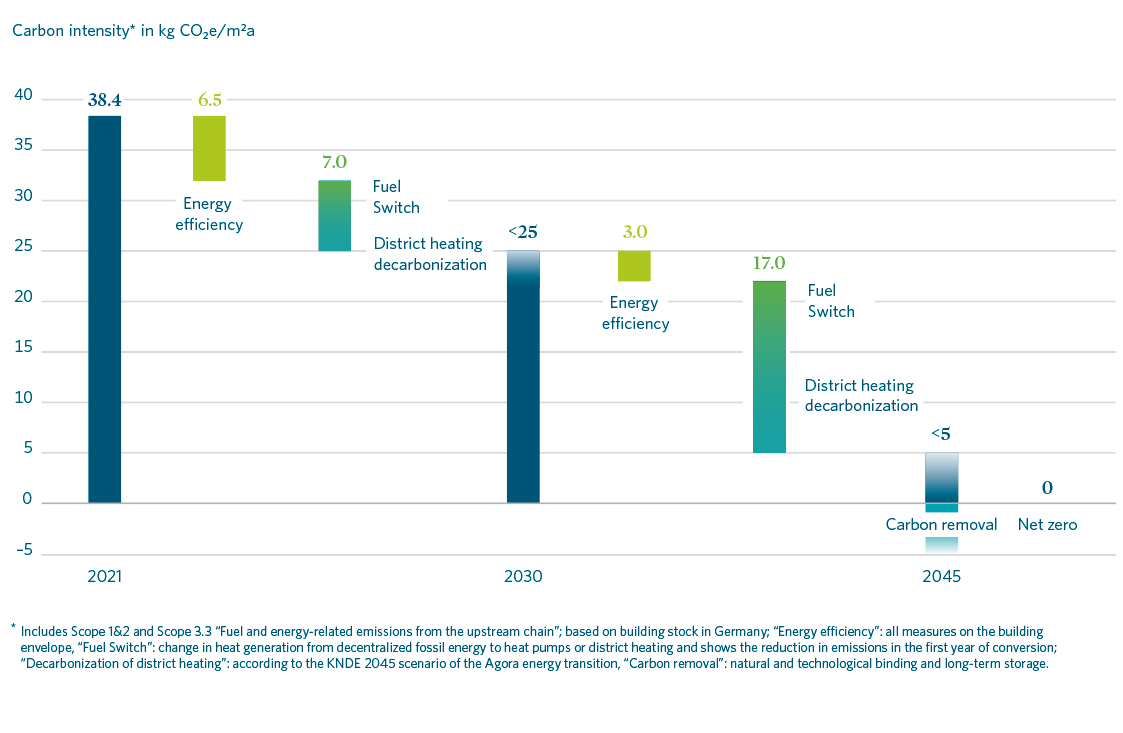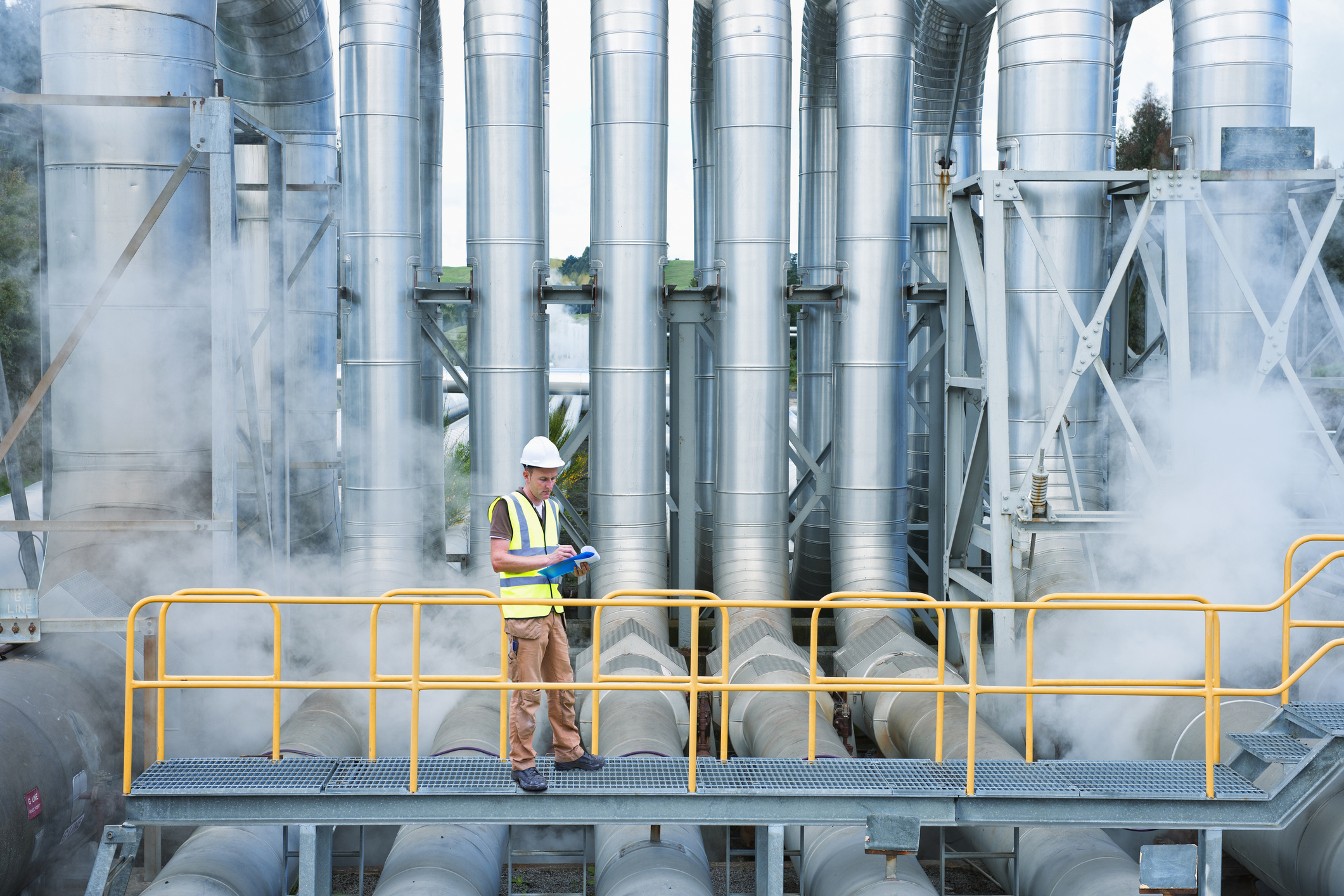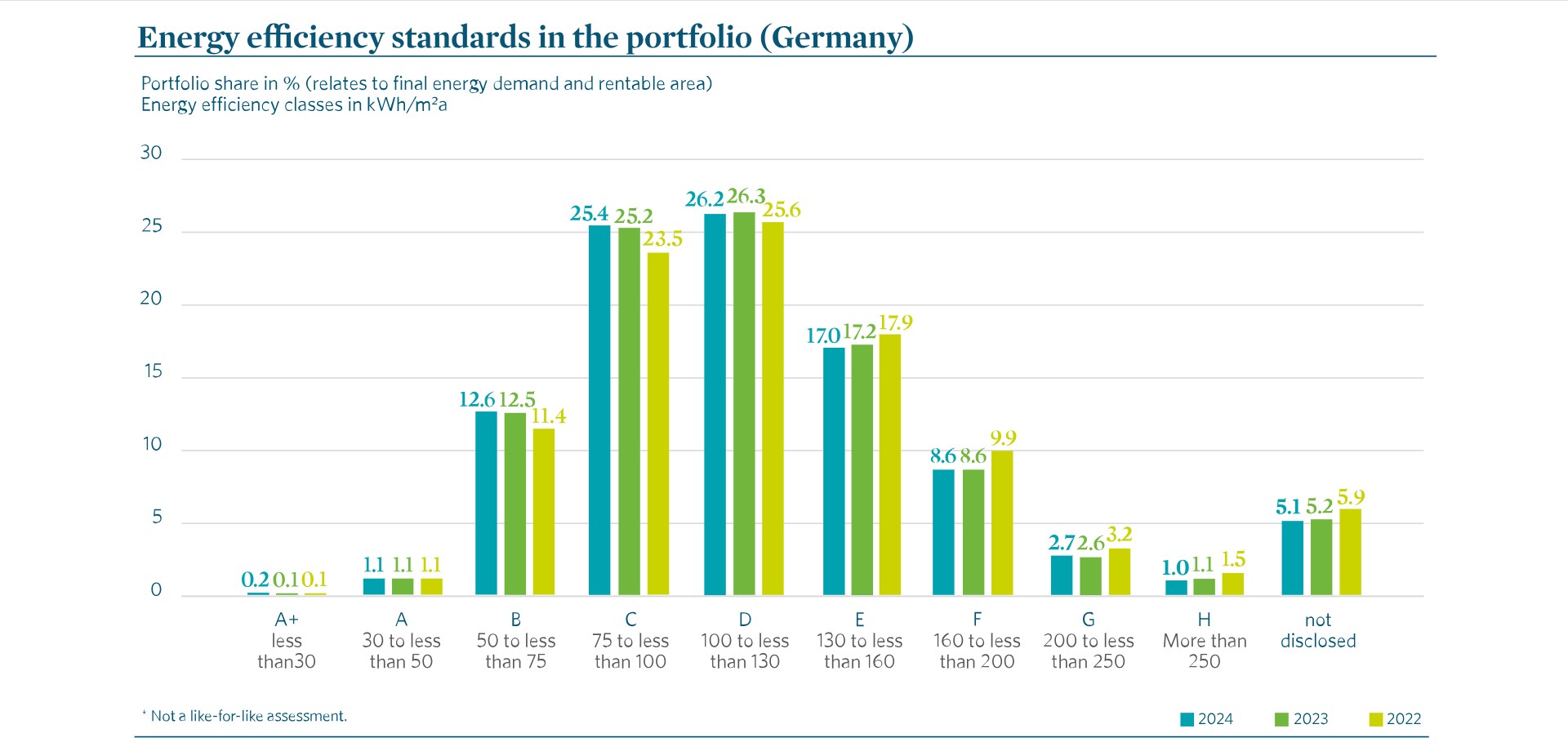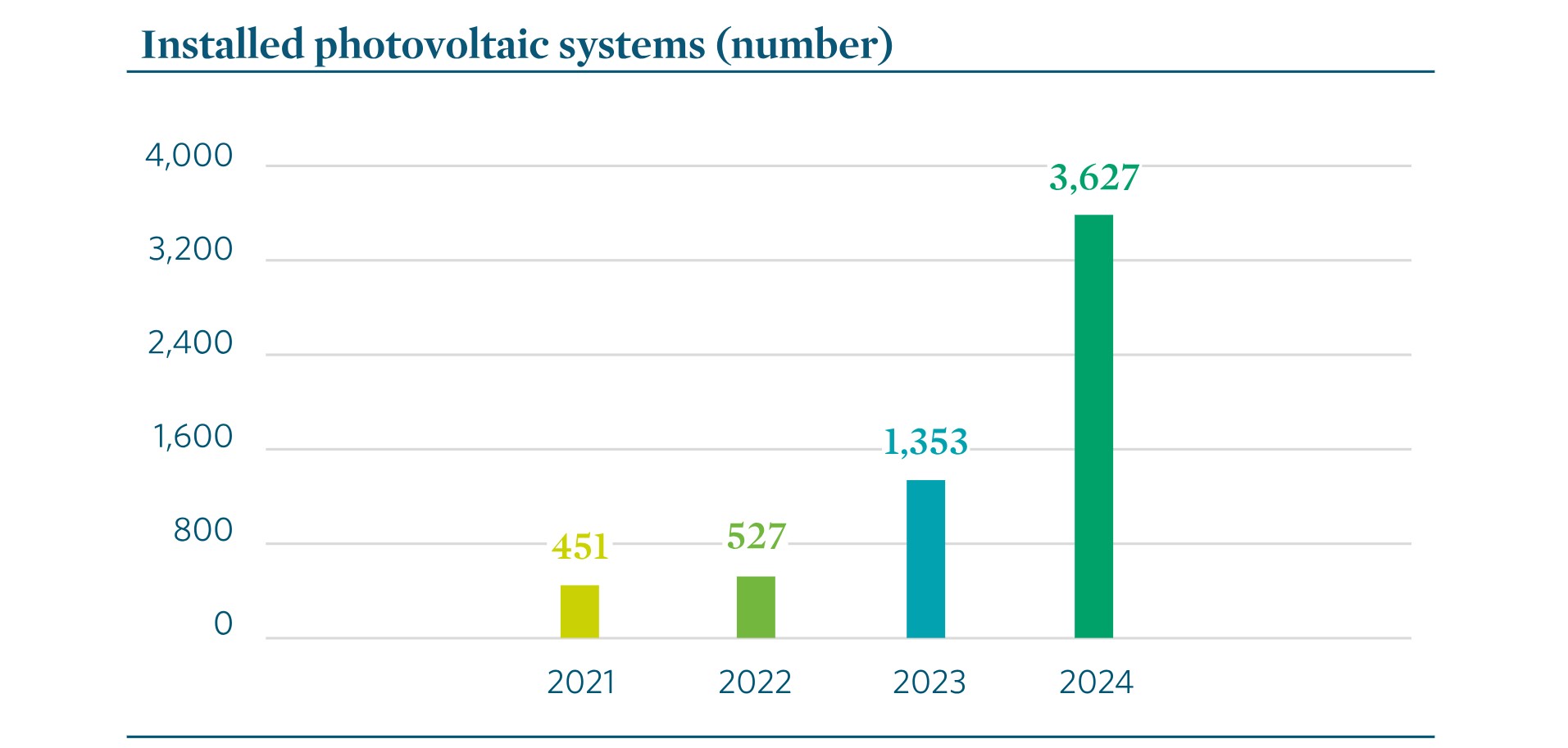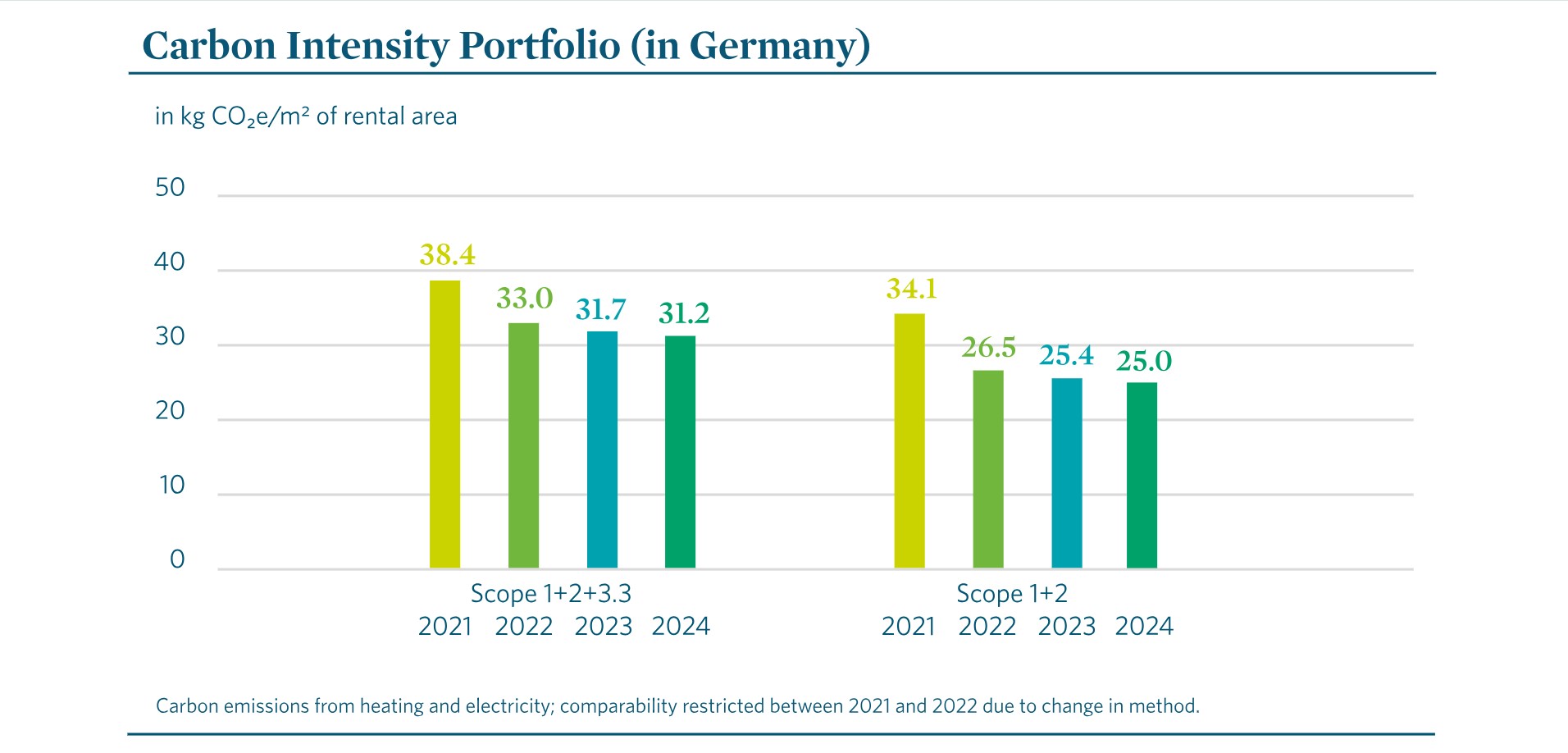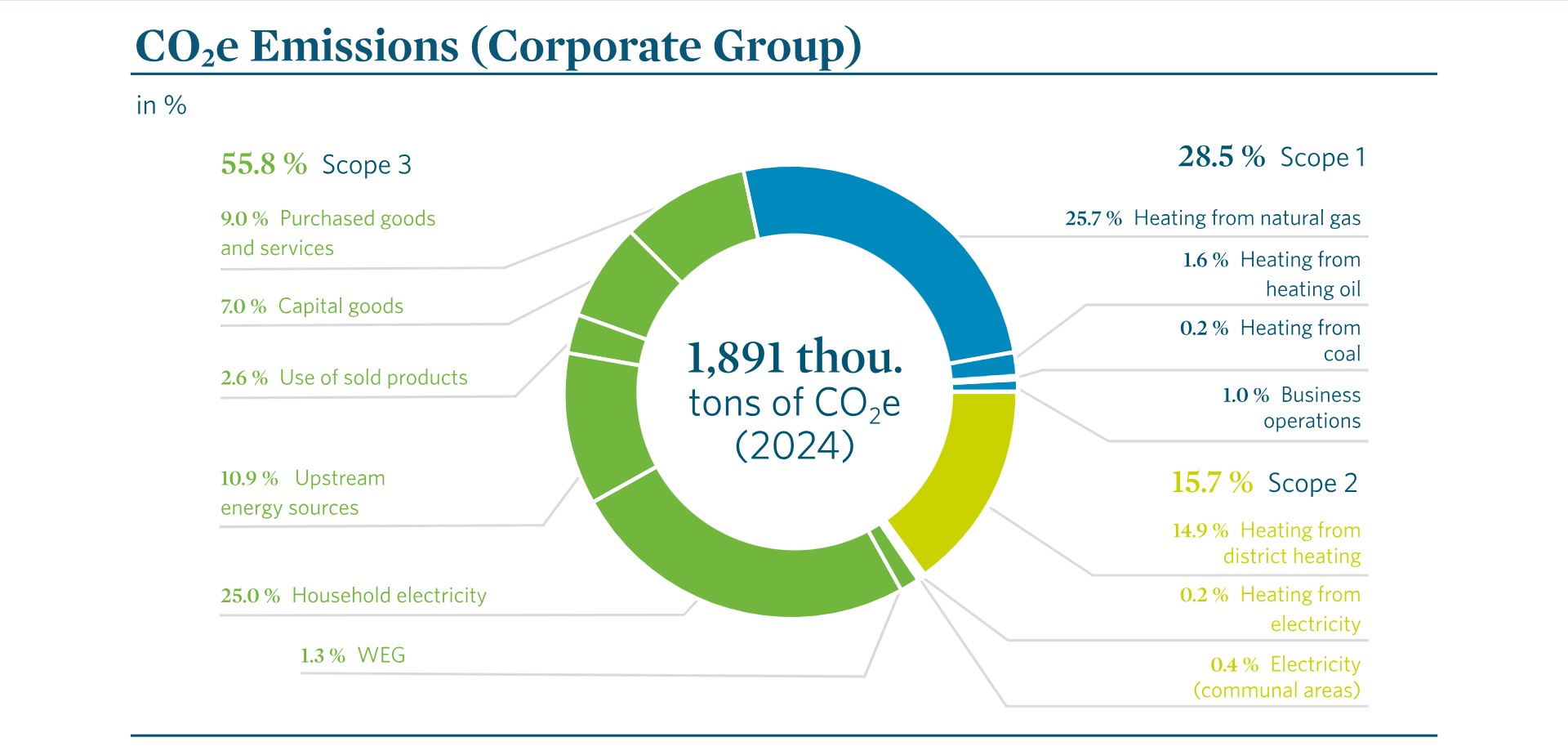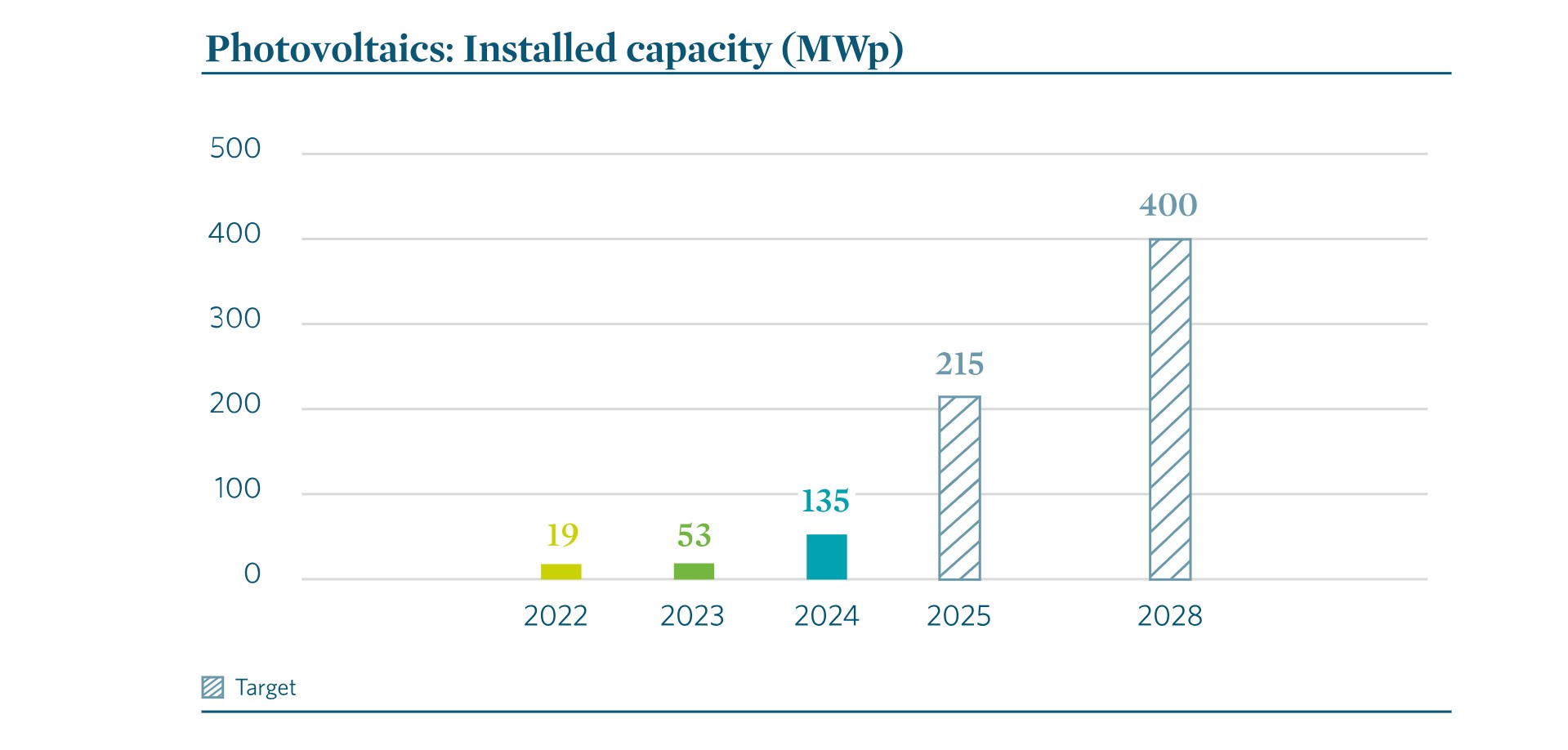Act reliably
Our Annual Report
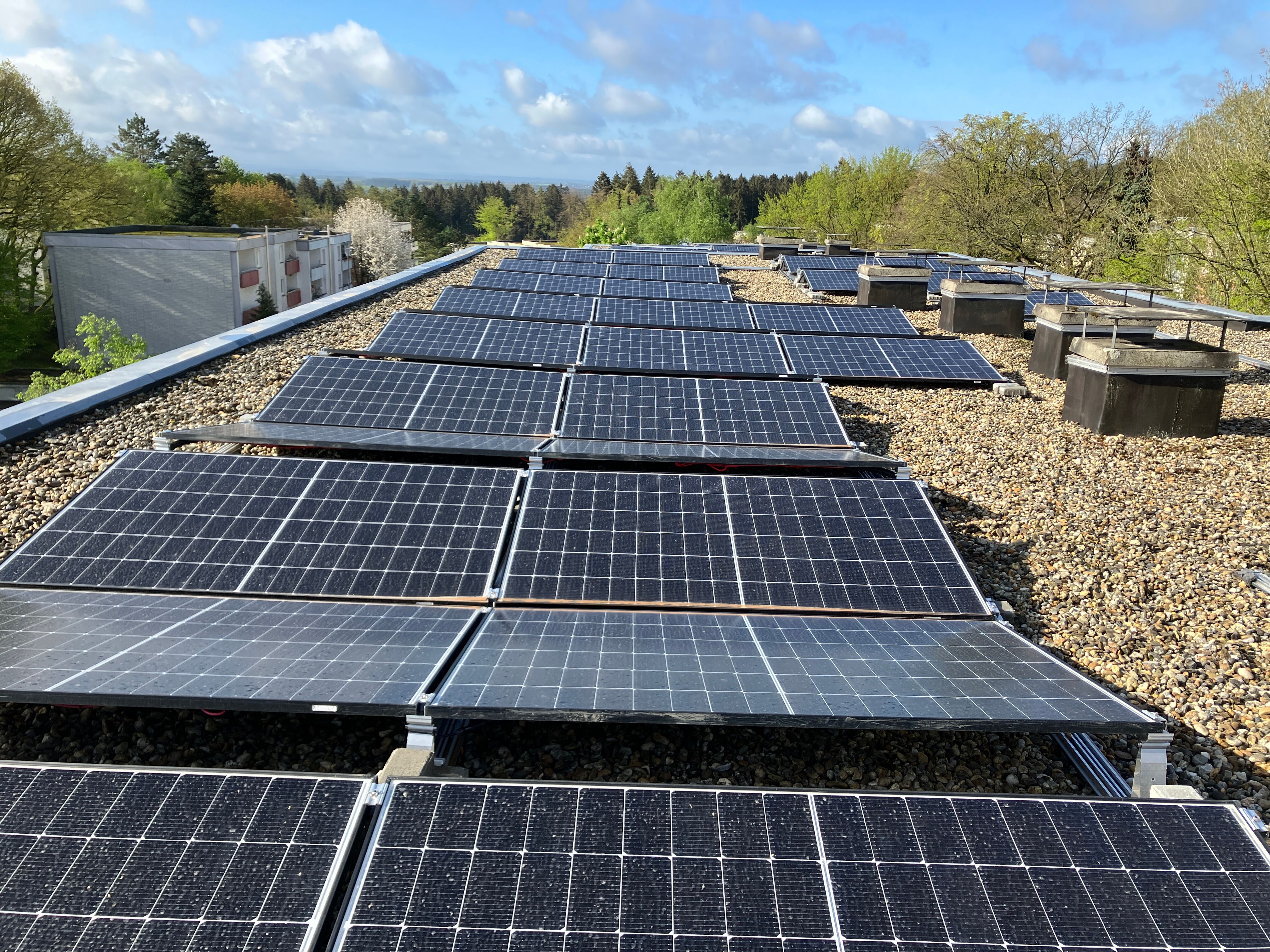
We are committed to achieving a climate-neutral housing stock by 2045 through extensive efforts. This includes modernizing our neighborhoods for enhanced energy efficiency, scaling up renewable energy generation, phasing out fossil fuels, and deploying innovative technologies for heat generation and storage.
The central indicator for managing our climate protection performance is the CO2 intensity of our housing portfolio. It is also a crucial component of the Sustainability Performance Index (SPI) and thereby influences corporate governance and the compensation of top executives. In the reporting year, the CO2 intensity for our real estate portfolio in Germany was 31.2 kg CO2e/m² rentable area, approximately 1.6 % lower than the previous year (2023: 31.7 kg CO2e/m²).
At the end of 2024, Vonovia owned 3,627 photovoltaic systems with an installed output of 134.8 MWp surpassing the target of 133.1 MWp.
Medium term target 2030: Vonovia has set itself the target of achieving a climate-neutral housing stock by 2045, with carbon intensity of less than 5 kg of CO2e per m2 of rental area (based on Scope 1, 2 and 3.3). By 2030, our housing stock in Germany is to have a CO2 intensity of less than 25 kg CO2e/sqm.
The unavoidable residual emissions that remain in 2045 are to be offset through appropriate and yet-to-be-defined measures, in order to achieve net-zero carbon intensity.
We are also aiming to have installed photovoltaics systems with a nominal installed output of around 400 MWp by 2028. In the long term, we aim to expand our PV capacity to up to 700 MWp.
In March 2024, the Science-based Target initiative (SBTi) confirmed that the near-term targets set and submitted by Vonovia SE are in line with the 1.5-degree goal of the Paris Agreement:
“Vonovia SE is committed to reducing absolute Scope 1 and 2 greenhouse gas emissions by 42% by 2030 compared to the base year 2021. Vonovia SE is also committed to reducing absolute Scope 3 greenhouse gas emissions from the categories “Fuel and energy-related activities,” “Use of sold products” and “Downstream leased assets” by 25% by 2030.
This places us among the six companies in the German real estate sector to receive such confirmation from the SBTi. Across Europe, only 45 companies in the real estate sector have achieved this distinction.
The Science-based Target initiative (SBTi) is a non-profit organization that establishes standards and benchmarks to assess whether greenhouse gas (GHG) targets are sufficient to meet the global challenge of limiting global warming to levels deemed critical by the global community and achieving net zero emissions by 2050.
The SBTi is formed by the CDP, the United Nations Global Compact, the We Mean Business Coalition, the World Resources Institute (WRI) and the World Wide Fund for Nature (WWF).
You can find further details about our climate opportunities and risks in the Annual Report, our responses to the CDP rating, and in the information about our implementation of the TCFD recommendations.
We see substantial opportunities in climate protection. These include reducing energy and CO₂ costs through efficiency improvements and expanding photovoltaics. Photovoltaics enhance property appeal to our customers, increase property values, and broaden our market reach. Achieving faster progress than planned on our climate path could have a positive impact on earnings and value development.
Framework conditions and market influences related to climate protection may change, for example, due to new regulations or shifts in technologies or demand (‘transition risks’). For instance, there is a risk that the CO₂ price could increase significantly beyond expectations or that the government may implement stricter regulations on refurbishments.
We see substantial opportunities in climate protection. These include reducing energy and CO₂ costs through efficiency improvements and expanding photovoltaics. Photovoltaics enhance property appeal to our customers, increase property values, and broaden our market reach. Achieving faster progress than planned on our climate path could have a positive impact on earnings and value development.
Framework conditions and market influences related to climate protection may change, for example, due to new regulations or shifts in technologies or demand (‘transition risks’). For instance, there is a risk that the CO₂ price could increase significantly beyond expectations or that the government may implement stricter regulations on refurbishments.
In our business strategy, the transformation plan for our housing stock, our climate path, is structured around three key levers:
Vonovia operationalizes its transformation plan using the Decarbonization Tool (DCT), which evaluates its housing stock based on ecological and economic criteria. The DCT prioritizes refurbishment initiatives for individual buildings over time, consolidating them into a comprehensive plan. Economic viability and emissions reduction are closely intertwined elements of this strategic process. The outcome of this prioritization is detailed further in energy-efficient refurbishment plans and energy concepts. We adopt a holistic approach at the neighborhood level, considering both building envelope upgrades (such as facade insulation, basement ceiling and attic insulation, and window replacement) and the transition to climate-friendly energy systems within a broader context. Our strategy follows a phased development approach, adjusting the timing of measures based on the initial energy efficiency status of buildings to meet the 2045 targets outlined in our climate pathway. In terms of implementation, tailored and economically feasible concepts are devised for scalable solutions, focusing on integrating the heat, electricity, and mobility sectors.
Energy-related refurbishment to enhance energy efficiency is a cornerstone of Vonovia’s climate pathway. Utilizing our in-house developed Decarbonization Tool (DCT), we create individualized energy refurbishment and energy concept plans for each building. Our focus on improving energy efficiency includes various measures such as insulating facades, cellar ceilings, and attics, as well as replacing windows. We leverage public-sector subsidy programs for many of these refurbishment initiatives to minimize costs for our tenants, notably including federal subsidies for energy-efficient buildings (BEG).
Since 2022, we have been accelerating the electrification of heat generation through our heat pump initiative. As a new concept for the electrification of heat, we piloted the “EnerCube.” This compact heat pump unit integrates all necessary components into an external module, supplies multiple buildings, and can be installed quickly outside the buildings. Following successful pilot projects in Bochum and Witten covering around 130 residential units, additional projects comprising approximately 200 units are currently being implemented across Germany, with many more in the planning stage.
We are also advocating for transparency regarding environmental impacts throughout the entire lifecycle of materials and products used in energy refurbishments. Through a comprehensive analysis of historical purchasing data, we calculated the carbon footprint associated with the materials and services utilized, identifying significant hotspots. They are particularly related to windows, insulation materials, and heating systems. The next phase involves integrating these calculations into our data systems.
As part of advancing our climate pathway, Vonovia has continued its program launched in 2021 to expand electricity generation through photovoltaics in the reporting year. The focus remains on ensuring direct utilization of generated electricity within the neighborhood to supply our tenants and operate heat pumps. This integration of systems closely aligns with our heat pump initiative and refurbishment program.
By the end of the reporting year, Vonovia owned 3,627 photovoltaic systems with an installed capacity of 134.8 MWp, clearly surpassing the target 133.1 MWp. In the coming years, we will continue to significantly expand our photovoltaic capacity. By 2028, we aim to install around 400 MWp, with a long-term goal of reaching up to 700 MWp. For the 2025 financial year, we are targeting an additional capacity of 80 MWp.
Our long-term objective is to equip all suitable roof spaces in our German portfolio with PV panels by 2050. Through our subsidiary energy supply company (VESG), we supply our customers with electricity sourced from renewable energies. Communal areas already receive certified green electricity. By providing locally generated or certified green energy, we supply approximately 45,000 households with around 50 GWh of affordable electricity, contributing to reduced greenhouse gas emissions. Two power supply contracts (Power Purchase Agreements) have been concluded for approximately 38 million kWh. The electricity is generated by a total of 15 wind turbines, avoiding around 28,800 tons of CO₂ equivalents.
To accelerate and enhance decision-making in specific neighborhood development projects, we employ continuous use of innovative technologies, including a simulation tool that rapidly maps various configurations of complex energy systems and flows within the neighborhood. In 2023, we initiated a pilot project to select and implement an energy management system aimed at operationalizing a centralized technical system for efficient operational control, optimization, and flexible marketing of electricity generation from photovoltaics.
Another crucial lever for our climate strategy involves ensuring sufficient supply of carbon-neutral district heating and electricity from the energy sector. This requires the energy sector to adhere to policymakers' targets for phasing out coal and increasing the proportion of renewable energies in energy and electricity generation. We view the mandatory municipal heating planning process as a significant step toward achieving this objective. It offers long-term planning certainty regarding the availability of district heating across municipalities. The German Heat Planning Act also includes mandatory targets for decarbonizing heating networks.
A notable practical example is the Bochum heat transition project, in which Vonovia is actively involved. A key aspect of this initiative involves adopting an integrated approach to heat and electricity generation that considers all stakeholders within the municipality. District heating represents a significant lever for us, particularly where connecting additional properties to district heating networks is economically feasible, while advancing the decarbonization of heat generation by public utilities companies. Consequently, Vonovia is evaluating the decarbonization strategies of major district heating providers and, based on these assessments, developing potential strategies to integrate them into its long-term neighborhood strategy.
In Austria, BUWOG has partnered with the “klimaaktiv Pakt” since 2011”, a climate protection initiative launched by the Austrian Federal Ministry for Climate Action, Environment, Energy, Mobility, Innovation, and Technology (BMK). As part of this initiative, BUWOG has set a target to reduce greenhouse gas emissions by 55% by 2030 compared to the baseline year of 2005. The majority of this reduction will come from modernizing and upgrading existing properties, with a strong focus on energy-efficient refurbishments, enhancing heating system efficiencies, and transitioning to renewable energy sources. Additionally, BUWOG plans to phase out all oil heating systems by 2030, five years ahead of legal requirements.
In Sweden, nearly all existing buildings owned by Victoriahem are connected to district heating systems that already cause very low CO₂ emissions. Therefore, the path to achieving climate neutrality is primarily determined by further decarbonizing the heating supply, alongside continuous enhancements in energy efficiency. The objective is to reduce energy consumption per square meter by 30% by 2030 compared to 2015. Victoriahem is also a participant in the Swedish housing association’s "Allmännyttans klimatinitiativ", which aims to achieve a CO₂-free energy supply by 2030.

